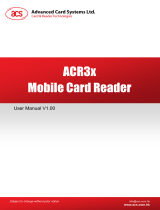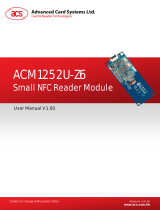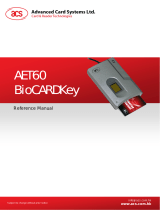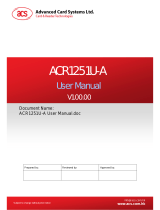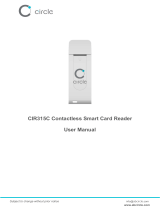Page is loading ...

Subject to change without prior notice info@acs.com.hk
www.acs.com.hk
Reference Manual V1.03
ACR3x Mobile
Card Reader

ACR3x – Reference Manual info@acs.com.hk
Version 1.03
www.acs.com.hk
Page 2 of 77
Table of Contents
1.0. Introduction ............................................................................................................. 5
1.1. Definitions of Terms ............................................................................................................... 5
2.0. Features ................................................................................................................... 6
2.1. ACR31 ................................................................................................................................... 6
2.2. ACR32 ................................................................................................................................... 7
2.3. ACR35 ................................................................................................................................... 8
3.0. Supported Cards ..................................................................................................... 9
3.1. Magnetic Cards ...................................................................................................................... 9
3.2. MCU Cards ............................................................................................................................ 9
3.3. Memory-based Smart Cards.................................................................................................. 9
3.4. Contactless Cards ............................................................................................................... 10
4.0. System Block Design ............................................................................................ 11
4.1. ACR31 ................................................................................................................................. 11
4.2. ACR32 ................................................................................................................................. 12
4.3. ACR35 ................................................................................................................................. 13
5.0. Hardware Design ................................................................................................... 14
5.1. Battery .................................................................................................................................. 14
5.2. Status LED ........................................................................................................................... 14
5.3. Micro USB Interface ............................................................................................................. 14
5.4. Audio Channel ..................................................................................................................... 14
5.4.1. Communication Parameters ....................................................................................... 14
5.5. Magnetic Stripe Card Interface ............................................................................................ 14
5.6. Smart Card Interface ........................................................................................................... 15
5.6.1. Smart Card Power Supply VCC (C1) .......................................................................... 15
5.6.2. Programming Voltage VPP (C6) ................................................................................. 15
5.6.3. Card Type Selection.................................................................................................... 15
5.6.4. Interface for Microcontroller-based Cards................................................................... 15
5.6.5. Card Tearing Protection .............................................................................................. 15
6.0. Communication Protocol ...................................................................................... 16
7.0. Application Programming Interface ..................................................................... 17
8.0. Contact Card Commands ...................................................................................... 18
8.1. Memory Card – 1, 2, 4, 8, and 16 kilobit I2C Card .............................................................. 18
8.1.1. SELECT_CARD_TYPE .............................................................................................. 18
8.1.2. SELECT_PAGE_SIZE ................................................................................................ 18
8.1.3. READ_MEMORY_CARD ............................................................................................ 19
8.1.4. WRITE_MEMORY_CARD .......................................................................................... 19
8.2. Memory Card – 32, 64, 128, 256, 512, and 1024 kilobit I2C Card ...................................... 21
8.2.1. SELECT_CARD_TYPE .............................................................................................. 21
8.2.2. SELECT_PAGE_SIZE ................................................................................................ 21
8.2.3. READ_MEMORY_CARD ............................................................................................ 22
8.2.4. WRITE_MEMORY_CARD .......................................................................................... 22
8.3. Memory Card – Atmel
®
AT88SC153 ................................................................................... 24
8.3.1. SELECT_CARD_TYPE .............................................................................................. 24
8.3.2. READ_MEMORY_CARD ............................................................................................ 24
8.3.3. WRITE_MEMORY_CARD .......................................................................................... 25
8.3.4. VERIFY_PASSWORD ................................................................................................ 26
8.3.5. INITIALIZE_AUTHENTICATION ................................................................................. 26
8.3.6. VERIFY_AUTHENTICATION ..................................................................................... 27
8.4. Memory Card – Atmel
®
AT88C1608 .................................................................................... 28
8.4.1. SELECT_CARD_TYPE .............................................................................................. 28

ACR3x – Reference Manual info@acs.com.hk
Version 1.03
www.acs.com.hk
Page 3 of 77
8.4.2. READ_MEMORY_CARD ............................................................................................ 28
8.4.3. WRITE_MEMORY_CARD .......................................................................................... 29
8.4.4. VERIFY_PASSWORD ................................................................................................ 30
8.4.5. INITIALIZE_AUTHENTICATION ................................................................................. 30
8.4.6. VERIFY_AUTHENTICATION ..................................................................................... 31
8.5. Memory Card – SLE4418/SLE4428/SLE5518/SLE5528 .................................................... 32
8.5.1. SELECT_CARD_TYPE .............................................................................................. 32
8.5.2. READ_MEMORY_CARD ............................................................................................ 32
8.5.3. READ_PRESENTATION_ERROR_COUNTER_MEMORY_CARD (SLE4428 and
SLE5528) .................................................................................................................... 33
8.5.4. READ_PROTECTION_BIT ......................................................................................... 33
8.5.5. WRITE_MEMORY_CARD .......................................................................................... 34
8.5.6. WRITE_PROTECTION_MEMORY_CARD ................................................................ 35
8.5.7. PRESENT_CODE_MEMORY_CARD (SLE4428 and SLE5528) ............................... 35
8.6. Memory Card – SLE4432/SLE4442/SLE5532/SLE5542 .................................................... 37
8.6.1. SELECT_CARD_TYPE .............................................................................................. 37
8.6.2. READ_MEMORY_CARD ............................................................................................ 37
8.6.3. READ_PRESENTATION_ERROR_COUNTER_MEMORY_CARD (SLE4442 and
SLE5542) .................................................................................................................... 38
8.6.4. READ_PROTECTION_BITS ...................................................................................... 38
8.6.5. WRITE_MEMORY_CARD .......................................................................................... 39
8.6.6. WRITE_PROTECTION_MEMORY_CARD ................................................................ 39
8.6.7. PRESENT_CODE_MEMORY_CARD (SLE4442 and SLE5542) ............................... 40
8.6.8. CHANGE_CODE_MEMORY_CARD (SLE4442 and SLE5542) ................................ 41
8.7. Memory Card – SLE4406/SLE4436/SLE5536/SLE6636 .................................................... 42
8.7.1. SELECT_CARD_TYPE .............................................................................................. 42
8.7.2. READ_MEMORY_CARD ............................................................................................ 42
8.7.3. WRITE_ONE_BYTE_MEMORY_CARD ..................................................................... 43
8.7.4. PRESENT_CODE_MEMORY_CARD ........................................................................ 44
8.7.5. AUTHENTICATE_MEMORY_CARD (SLE4436, SLE5536 and SLE6636) ................ 44
8.8. Memory Card – SLE 4404 ................................................................................................... 46
8.8.1. SELECT_CARD_TYPE .............................................................................................. 46
8.8.2. READ_MEMORY_CARD ............................................................................................ 46
8.8.3. WRITE_MEMORY_CARD .......................................................................................... 47
8.8.4. ERASE_SCRATCH_PAD_MEMORY_CARD ............................................................ 47
8.8.5. VERIFY_USER_CODE ............................................................................................... 48
8.8.6. VERIFY_MEMORY_CODE ........................................................................................ 49
8.9. Memory Card – AT88SC101/AT88SC102/AT88SC1003 .................................................... 50
8.9.1. SELECT_CARD_TYPE .............................................................................................. 50
8.9.2. READ_MEMORY_CARD ............................................................................................ 50
8.9.3. WRITE_MEMORY_CARD .......................................................................................... 51
8.9.4. ERASE_NON_APPLICATION_ZONE ........................................................................ 51
8.9.5. ERASE_APPLICATION_ZONE_WITH_ERASE ........................................................ 52
8.9.6. ERASE_APPLICATION_ZONE_WITH_WRITE_AND_ERASE ................................. 53
8.9.7. VERIFY_SECURITY_CODE ...................................................................................... 54
8.9.8. BLOWN_FUSE ........................................................................................................... 55
9.0. Contactless Card Commands ............................................................................... 57
9.1. Pseudo APDU for Contactless Interface ............................................................................. 57
9.1.1. Get Data ...................................................................................................................... 57
9.2. PICC Commands (T=CL Emulation) for MIFARE Classic 1K/4K Memory Cards ............... 58
9.2.1. Load Authentication Keys ........................................................................................... 58
9.2.2. Authentication for MIFARE Classic (1K/4K) ............................................................... 59
9.2.3. Read Binary Blocks ..................................................................................................... 62
9.2.4. Update Binary Blocks .................................................................................................. 63
9.2.5. Value Block Operation (INC, DEC, STORE) .............................................................. 64
9.2.6. Read Value Block ........................................................................................................ 65
9.2.7. Copy Value Block ........................................................................................................ 66
9.2.8. Access PC/SC Compliant Tags (ISO14443-4) ........................................................... 67
9.2.9. Access FeliCa Tags .................................................................................................... 68

ACR3x – Reference Manual info@acs.com.hk
Version 1.03
www.acs.com.hk
Page 4 of 77
10.0. Sensitive Data Injection Method ........................................................................... 69
10.1. Authentication ...................................................................................................................... 69
10.2. Customer Master Key Injection............................................................................................ 71
10.3. AES Key Injection ................................................................................................................ 71
10.4. DUKPT Initialization ............................................................................................................. 72
11.0. Card Data Encryption ............................................................................................ 73
12.0. AES-128 CBC Encryption Test Vectors ............................................................... 74
13.0. TDES ECB Encryption Test Vectors ..................................................................... 75
Appendix A. Track Data Error Code .............................................................................. 76
Appendix B. System Error Codes ................................................................................. 77
List of Figures
Figure 1 : ACR31 Architecture ............................................................................................................. 11
Figure 2 : ACR32 Architecture ............................................................................................................. 12
Figure 3 : ACR35 Architecture ............................................................................................................. 13
Figure 4 : Sensitive Data Injection Model ............................................................................................. 69
Figure 5 : Authentication Procedure ..................................................................................................... 70
List of Tables
Table 1 : Definitions of Terms ................................................................................................................. 5
Table 2 : 3.5 mm Audio Socket Wiring ................................................................................................. 14
Table 3 : MIFARE Classic 1K Memory Map ......................................................................................... 60
Table 4 : MIFARE Classic 4K Memory Map ......................................................................................... 60
Table 5 : MIFARE Ultralight Memory Map ............................................................................................ 61
Table 6 : System Error Codes .............................................................................................................. 77

ACR3x – Reference Manual info@acs.com.hk
Version 1.03
www.acs.com.hk
Page 5 of 77
1.0. Introduction
The ACR3x Mobile Card Reader serves as an interface for the communication between a mobile
device and a magnetic/contact/contactless card. Different types of cards have different commands
and communication protocols, and the ACR3x establishes a uniform interface from the mobile device
to the card.
The ACR3x is connected to the mobile device through a 3.5 mm audio jack interface. Through this,
the ACR3x will read information from the cards through the decoder on the reader which will be sent
to the mobile device, such as smartphone or tablet. Furthermore, as a way to enhance security, the
card information is encrypted using the AES-128 encryption algorithm before it will be sent to the
backend server.
This document describes the hardware and software design of the ACR3x and the list of commands it
uses to communicate with the mobile device.
1.1. Definitions of Terms
Abbreviation Description
ACS Secret Key
Key used to perform Master Reset authentication. This key cannot be
modified through command messages and is hard coded in the
firmware. This key must be kept securely by ACS only.
AES Advanced Encryption Standard
AES Key
The key used to encrypt the magnetic stripe track data using AES-128
CBC cipher mode. This key can be modified by the customer.
Custom ID
10 bytes of identification code set by customer. This ID can be
modified by the customer.
Customer Master Key
The key being kept by the customer to perform authentication with
ACR3x before the injection of AES Key, new Customer Master Key,
Custom ID and DUKPT option, as well as performing DUKPT
initialization. This key can be modified by the customer
Device ID
8 bytes of unique identification code of the MCU used in ACR3x.
Customer can use this ID to derive the Custom ID or DUKPT
initialization data. This ID cannot be modified by any means and is
hard coded inside the MCU by the MCU manufacturer.
Master Reset
This term is equivalent to factory reset. By performing a Master Reset,
all the data stored in the flash memory will be erased and set to
default values
MReset Session Key
Key being created uniquely after each success mutual authentication
for Master Reset
Session Key
Key being created uniquely after each success mutual authentication
for sensitive data injection
TDES Triple Data Encryption Standard
Table 1: Definitions of Terms

ACR3x – Reference Manual info@acs.com.hk
Version 1.03
www.acs.com.hk
Page 6 of 77
2.0. Features
2.1. ACR31
• 3.5 mm Audio Jack Interface
• Powered by a CR2016 battery
• Reads up to two tracks of card data
• Capable of bi-directional reading
• Supports AES-128 encryption algorithm
• Supports DUKPT Key Management System
• Magnetic Stripe Card Reader:
o Supports ISO 7810/7811 magnetic cards
o Supports Hi-coercivity and Low-coercivity magnetic cards
o Supports JIS1 and JIS2
• Supports Android™ 2.3 and above
1
• Supports iOS 5.0 and above
2
• Compliant with the following standards:
o CE
o FCC
o VCCI
o RoHS 2
o REACH
1
Visit www.acs.com.hk for the list of supported devices
2
Same as above

ACR3x – Reference Manual info@acs.com.hk
Version 1.03
www.acs.com.hk
Page 7 of 77
2.2. ACR32
• 3.5 mm Audio Jack Interface
• USB Powered (PC-linked Mode):
o USB 2.0 Full Speed Interface
o CCID Compliance
o Application Programming Interface:
Supports PC/SC
Supports CT-API (through wrapper on top of PC/SC)
• Battery Powered:
o Powered by a Lithium-ion battery (rechargeable through PC-linked mode)
• Smart Card Reader:
o Supports ISO 7816 Class A, B and C (5 V, 3 V, 1.8 V) cards
o Supports microprocessor cards with T=0 and T=1 protocol
o Supports memory cards
o Supports PPS (Protocol and Parameters Selection)
o Features Short Circuit Protection
• Magnetic Stripe Card Reader:
o Reads up to two tracks of card data
o Capable of bi-directional reading
o Supports AES-128 encryption algorithm
o Supports DUKPT Key Management System
o Supports ISO 7810/7811 magnetic cards
o Supports Hi-coercivity and Low-coercivity magnetic cards
o Supports JIS1 and JIS2
• Supports Android™ 2.0 and above
3
• Supports iOS 5.0 and above
4
• Compliant with the following standards:
o EN60950/IEC 60950
o ISO 7816
o CE
o FCC
o VCCI
o PC/SC
o CCID
o EMV™ Contact Level 1
o Microsoft
® WHQL
o RoHS 2
o REACH
3
Visit www.acs.com.hk for the list of supported devices; PC/SC and CCID support are not applicable
4
Same as above

ACR3x – Reference Manual info@acs.com.hk
Version 1.03
www.acs.com.hk
Page 8 of 77
2.3. ACR35
• 3.5 mm Audio Jack Interface
• Powered by a Lithium-ion battery (rechargeable through USB cable)
• Smart Card Reader:
o Built-in antenna for contactless tag access, with reading distance of up to 20 mm
(depending on tag type)
o Supports ISO 14443 Part 4 Type A and B cards
o Supports MIFARE®
o Supports FeliCa
o Supports ISO 18092 Tags (NFC Tags)
5
o Built-in anti-collision feature (only one tag is accessed at any time)
o NFC Support:
Card reader/writer mode
• Magnetic Stripe Card Reader:
o Reads up to two tracks of card data
o Capable of bi-directional reading
o Supports AES-128 encryption algorithm
o Supports DUKPT Key Management System
o Supports ISO 7810/7811 magnetic cards
o Supports Hi-coercivity and Low-coercivity magnetic cards
o Supports JIS1 and JIS2
• Supports Android™ 2.0 and above
6
• Supports iOS 5.0 and above
7
• Compliant with the following standards:
o ISO 18092
o ISO 14443
o EN 6095/IEC 60950
o CE
o FCC
o VCCI
o RoHS 2
o REACH
5
Topaz type is excluded. Please contact ACS for more details.
6
Visit www.acs.com.hk for the list of supported devices.
7
Same as above

ACR3x – Reference Manual info@acs.com.hk
Version 1.03
www.acs.com.hk
Page 9 of 77
3.0. Supported Cards
3.1. Magnetic Cards
ACR3x operates with ISO 7810/7811 magnetic cards with Hi-coercivity and Low-coercivity.
3.2. MCU Cards
ACR32 is a PC/SC compliant smart card reader that supports ISO 7816 Class A, B and C (5 V, 3 V,
and 1.8 V) smart cards. It also works with MCU cards following either the T=0 and T=1 protocol.
The card ATR indicates the specific operation mode (TA2 present; bit 5 of TA2 must be 0) and when
that particular mode is not supported by the ACR32, it will reset the card to negotiable mode. If the
card cannot be set to negotiable mode, the reader will then reject the card.
When the card ATR indicates the negotiable mode (TA2 not present) and communication parameters
other than the default parameters, the ACR32 will execute the PPS and try to use the communication
parameters that the card suggested in its ATR. If the card does not accept the PPS, the reader will
use the default parameters (F=372, D=1).
For the meaning of the aforementioned parameters, please refer to ISO 7816-3.
3.3. Memory-based Smart Cards
ACR32 works with several memory-based smart cards such as:
• Cards following the I2C bus protocol (free memory cards) with maximum 128-byte page with
capability, including:
o Atmel®: AT24C01/02/04/08/16/32/64/128/256/512/1024
o SGS-Thomson: ST14C02C, ST14C04C
o Gemplus: GFM1K, GFM2K, GFM4K, GFM8K
• Cards with secure memory IC with password and authentication, including:
o Atmel®: AT88SC153 and AT88SC1608
• Cards with intelligent 1-kilobyte EEPROM with write-protect function, including:
o Infineon®: SLE4418, SLE4428, SLE5518 and SLE5528
• Cards with intelligent 256-byte EEPROM with write-protect function, including:
o Infineon®: SLE4432, SLE4442, SLE5532 and SLE5542
• Cards with ‘104’ type EEPROM non-reloadable token counter cards, including:
o Infineon®: SLE4406, SLE4436, SLE5536 and SLE6636
• Cards with Intelligent 416-Bit EEPROM with internal PIN check, including:
o Infineon®: SLE4404
• Cards with Security Logic with Application Zone(s), including:
o Atmel®: AT88SC101, AT88SC102 and AT88SC1003

ACR3x – Reference Manual info@acs.com.hk
Version 1.03
www.acs.com.hk
Page 10 of 77
3.4. Contactless Cards
ACR35 works with various contactless cards and tags such as:
• ISO 14443 Type A cards
• ISO 14443 Type B cards
• ISO/IEC 18092 (NFC) cards
• MIFARE® Classic 1K/4K
• FeliCa
• MIFARE Ultralight®
• MIFARE Ultralight® C
• MIFARE® DESFire® EV1

ACR3x – Reference Manual info@acs.com.hk
Version 1.03
www.acs.com.hk
Page 11 of 77
4.0. System Block Design
4.1. ACR31
Figure 1: ACR31 Architecture
ACR31
ISO7810/7811
Magnetic Head
Magnetic Stripe
Decoder IC
MCU
Power
Management
Battery
Phone Jack
Mobile Device

ACR3x – Reference Manual info@acs.com.hk
Version 1.03
www.acs.com.hk
Page 12 of 77
4.2. ACR32
Figure 2: ACR32 Architecture
ACR32
ISO7810/7811
Magnetic Head
Magnetic Stripe
Decoder IC
MCU
Power
Management
Re-chargeable
battery
Phone Jack
Mobile Device
ACR3901 Smart
Card Reader IC
ISO7816

ACR3x – Reference Manual info@acs.com.hk
Version 1.03
www.acs.com.hk
Page 13 of 77
4.3. ACR35
Figure 3: ACR35 Architecture
ACR35
ISO7810/7811
Magnetic Head
Magnetic Stripe
Decoder IC
MCU
Power
Management
Re-chargeable
battery
Phone Jack
Mobile Device
13.56 MHz frequency
Built-in antenna
ACR1251
RF chip

ACR3x – Reference Manual info@acs.com.hk
Version 1.03
www.acs.com.hk
Page 14 of 77
5.0. Hardware Design
5.1. Battery
ACR31 is using a CR2016 battery which has a capacity of 90 mAh. On the other hand, ACR32 and
ACR35 are using a rechargeable Lithium-ion battery which has a capacity of 200 mAh.
5.2. Status LED
The different LED colors indicate the different states of ACR32 and ACR35, where:
• Green LED
Operational
• Red LED
Battery status
5.3. Micro USB Interface
The Micro USB port is to be used to connect the ACR32 and ACR35 to the computer as battery
charging port. This port is also to be used in order for the ACR32 to act as a PC-linked reader.
5.4. Audio Channel
5.4.1. Communication Parameters
ACR3x is connected to a mobile device through Audio Channel.
Pin Signal Function
1 Left Transmit the data to ACR3x
2 Right Wake up device signal
3 GND GND
4 MIC Transmit the data to smart phone
Table 2: 3.5 mm Audio Socket Wiring
5.5. Magnetic Stripe Card Interface
ACR3x can read any magnetic stripe card that conforms to ISO 7810/7811 standards. ISO 7810
specifies the physical characteristics of the card, while ISO 7811 specifies the recording technique
used in identification cards.
High-coercivity (Hi-Co) magnetic stripes are typically black in color and are encoded with a stronger
magnetic field (2750 Oersted). This makes Hi-Co cards more durable because the data encoded on
the stripes are less likely to be unintentionally erased when exposed to an outside magnetic field.
When swiped across the magnetic head, Hi-Co magnetic stripes can induce larger signal pulses and
are more easily detected and decoded.
Low-coercivity (Lo-Co) magnetic stripes are generally brown in color and are encoded with lower
magnetic field intensity (300 Oersted). They will induce small signal pulses compared to Hi-Co cards
when swiped across the magnetic head. As a result, the Signal-Noise (S/N) ratio is relatively low and
they are more vulnerable to noise interference. A more sophisticated hardware support and signal
processing algorithm are needed to decode the signal correctly.
Since the magnetic fields of Hi-Co and Lo-Co cards are different, a magnetic stripe decoder IC with
automatic gain control can be used in the design to cater these two types of cards.

ACR3x – Reference Manual info@acs.com.hk
Version 1.03
www.acs.com.hk
Page 15 of 77
5.6. Smart Card Interface
The interface between the ACR32 and the inserted smart card follows the specification of ISO 7816-3
with certain restrictions or enhancements to increase the practical functionality of ACR32.
5.6.1. Smart Card Power Supply VCC (C1)
The current consumption of the inserted card must not be higher than 50 mA.
5.6.2. Programming Voltage VPP (C6)
According to ISO 7816-3, the smart card contact C6 (VPP) supplies the programming voltage to the
smart card. Since all common smart cards in the market are EEPROM-based and do not require the
provision of an external programming voltage, the contact C6 (VPP) has been implemented as a
normal control signal in the ACR32. The electrical specifications of this contact are identical to those
of the signal RST (at contact C2).
5.6.3. Card Type Selection
The controlling PC must always select the card type through the proper command sent to the ACR32
prior to activating the inserted card. This includes both the memory cards and MCU-based cards.
For MCU-based cards, the reader allows to select the preferred protocol, T=0 or T=1. However, this
selection is only accepted and carried out by the reader through the PPS when the card inserted in
the reader supports both protocol types. Whenever an MCU-based card supports only one protocol
type, T=0 or
T=1, the reader automatically uses that protocol type, regardless of the protocol type
selected by the application.
5.6.4. Interface for Microcontroller-based Cards
For microcontroller-based smart cards, only the contacts C1 (VCC), C2 (RST), C3 (CLK), C5 (GND)
and C7 (I/O) are used. A frequency of 4 MHz is applied to the CLK signal (C3).
5.6.5. Card Tearing Protection
The ACR32 provides a mechanism to protect the inserted card when it is suddenly withdrawn while it
is powered up. The power supply to the card and the signal lines between the ACR32 and the card is
immediately deactivated when the card is being removed. However, as a rule to avoid any electrical
damage, a card should only be removed from the reader while it is powered down.
Note: The ACR32 never switches on the power supply to the inserted card by itself. The controlling
computer through the proper command sent to the reader must explicitly do this.

ACR3x – Reference Manual info@acs.com.hk
Version 1.03
www.acs.com.hk
Page 16 of 77
6.0. Communication Protocol
ACR3x is a slave device and almost all operations are initiated by the mobile device. The mobile
device that sends the command is carried out in the form of successive command request-response
exchange. Additionally, the new request message should wait until previous response message has
been received
ACR3x will communicate with a mobile device through its audio jack interface. The communication
channel is bi-directional, with the reader sending data to the mobile device through the MIC pin of the
audio jack while the mobile device sending commands to the reader through the Right-Channel of the
audio jack.
While it is not operating, the ACR3x will remain in deep sleep mode. Upon receiving a wake up signal
from the mobile device through the Left-Channel of the audio jack, the ACR3x will wake up and send
back an acknowledgement signal to the mobile device. ACR3x will then wait for the swipe of the
magnetic stripe card within a timeout limit. After successfully obtaining the data from the swiped card,
the ACR3x will perform AES-128 encryption on the received card data and send back the encrypted
data to the mobile device in communication. If the reader fails to obtain a card swipe or command
message within the timeout limit, the ACR3x will send back the corresponding status to the mobile
device. After which, ACR3x will go back to deep sleep mode to save battery power.
Before the communication protocol between the ACR3x and the mobile device employ a direct signal
feeding, the signal received from the ACR3x will be passing through a DC offset cancellation filter.
The data to be transmitted will be encoded using the Manchester coding scheme (conforms to IEEE
802.3), with the clock frequency used in the Manchester coding scheme being set at 10 kHz. Since
the data transmission speed in the Manchester coding scheme always matches the clock speed, a
maximum baud rate of around 10 Kbps could be achieved.
The signal interpretation on the mobile device and ACR3x is based on sampling the corresponding
input waveforms. The sampling frequency should be at least double the clock frequency (Nyquist rate)
used in the Manchester coding scheme. After sampling the signals, the data encoded in the signals
could be received by determining the logical zero-crossing time.

ACR3x – Reference Manual info@acs.com.hk
Version 1.03
www.acs.com.hk
Page 17 of 77
7.0. Application Programming Interface
Please refer to the HTML files included in the ACR3x Android Library or ACR3x iOS Library.
The libraries may be downloaded from ACS website.

ACR3x – Reference Manual info@acs.com.hk
Version 1.03
www.acs.com.hk
Page 18 of 77
8.0. Contact Card Commands
This section contains the memory card command set for ACR32.
8.1. Memory Card – 1, 2, 4, 8, and 16 kilobit I2C Card
8.1.1. SELECT_CARD_TYPE
This command powers down and up the selected card inserted in the card reader and performs a card
reset.
Note: This command can only be used after the logical smart card reader communication has been
established using the SCardConnect( ) API. For details of SCardConnect( ) API, please refer to
PC/SC specification.
Command Format
Pseudo-APDU
CLA INS P1 P2 Lc Card Type
FFh A4h 00h 00h 01h 01h
Response Data Format
SW1 SW2
Where:
SW1 SW2 = 90 00h if no error
8.1.2. SELECT_PAGE_SIZE
This command chooses the page size to read the smart card. The default value is 8-byte page write. It
will reset to default value whenever the card is removed or the reader is powered off.
Command Format
Pseudo-APDU
CLA INS P1 P2 Lc Page Size
FFh 01h 00h 00h 01h
Where:
Page size = 03h for 8-byte page write
= 04h for 16-byte page write
= 05h for 32-byte page write
= 06h for 64-byte page write
= 07h for 128-byte page write

ACR3x – Reference Manual info@acs.com.hk
Version 1.03
www.acs.com.hk
Page 19 of 77
Response Data Format
SW1 SW2
Where:
SW1 SW2 = 90 00h if no error
8.1.3. READ_MEMORY_CARD
Command Format
Pseudo-APDU
CLA INS
Byte Address
MEM_L
MSB LSB
FFh B0h
Where:
Byte Address Memory address location of the memory card
MEM_L Length of data to be read from the memory card
Response Data Format
BYTE 1 … BYTE N SW1 SW2
Where:
BYTE x Data read from memory card
SW1 SW2 = 90 00h if no error
8.1.4. WRITE_MEMORY_CARD
Command Format
Pseudo-APDU
CLA INS
Byte Address
MEM_L Byte 1 .... Byte n
MSB LSB
FFh D0h
Where:
Byte Address Memory address location of the memory card
MEM_L Length of data to be written to the memory card
Byte x Data to be written to the memory card

ACR3x – Reference Manual info@acs.com.hk
Version 1.03
www.acs.com.hk
Page 20 of 77
Response Data Format
SW1 SW2
Where:
SW1 SW2 = 90 00h if no error
/
